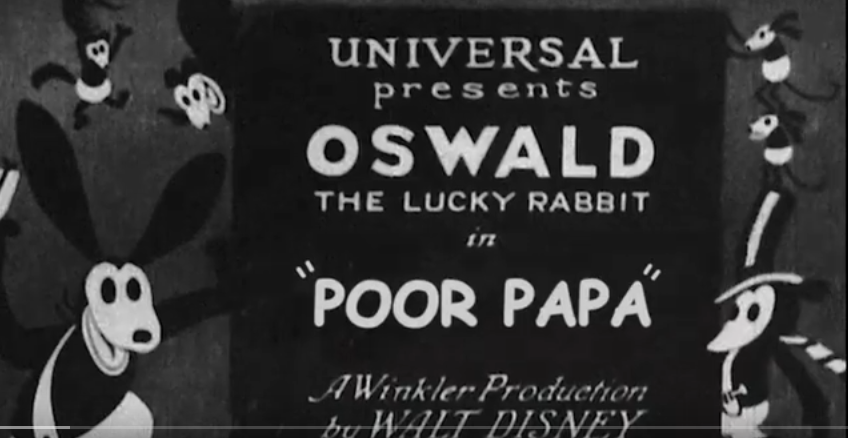|
In California, after moving from Kansas City, Missouri, Walt Disney and Ub Iwerks were continuing work on a series called Alice's Wonderland. These episodes were of a live-action girl in an animated background full of animated characters. It was a revolutionary process in its day and used well into the future by Disney. Walt knew the series was not destined to last forever, the technological limitations of the time would yield only so many gags and interesting scenarios. In 1927 Charles Mintz, a notable cartoon producer with Winkler Pictures, told Walt he was in negotiations to provide Universal Pictures with a new animated character as long as it wasn't of a cat. (One of Alice's episodes sported Julius the cat.) With the market flooded with cats, Walt had his head animator Ub Iwerks design different sketches of rabbits and sent them to Universal. On March 4th 1927, Oswald the Lucky Rabbit was signed on for 26 animated shorts. The first short entitled Poor Papa was finished by the end of April. Completed within a mere two week time frame, Mintz is said to have criticized the design of Oswald and Universal thought the film short lacked a sufficient story. Walt agreed with both of these criticisms and re-imagined Oswald's physical design and character. No animated character anywhere had ever had a set personality, the decision was groundbreaking for its day. The profile and physique Walt wanted was to make "Oswald peculiarly and typically Oswald." Walt believed, at least at the time, that shorts bogged down by story plots were typically the least successful so what he wanted was a personality that could really excite and resonate with audiences. Oswald's second appearance was in Trolley Troubles and performed miles above his initial debut. Some shots were actually from Oswald's point of view, an angle never done before in animation. It made headlines among the film trades, claiming Oswald was destined for stardom! Soon there was merchandise! Chocolate bars and pins were sold across the country and by the end of this first pivotal year, Walt's small two-man company had grown to accommodate 22 employees. Oswald became one of the biggest cartoons of the 1920s! Behind the scenes lay Charles Mintz who was scheming with Walt's animators to start a new studio. Walt was in fact warned this was happening but thought it too ridiculous to be true. However on February 2nd 1928, less than a year from the first Oswald short, Mintz and Universal signed a three-year contract entirely removing Walt from the Oswald shorts. Still Walt did not believe what he was hearing was true, he went to New York to not only negotiate his contract with Charles Mintz, but to negotiate for a bigger budget. He even brought his wife Lillian, considering the trip a second honeymoon. In Mintz's office, Walt expected to hear a counteroffer and he did. Mintz oddly offered Walt roughly 20 percent less money per Oswald short. After this meeting, Walt wired a message to his brother Roy back in California, "Break with Charlie Looming." Realizing the rumors he'd been hearing had been true, Walt also instructed Roy to draft a contract with each of his animators so he wouldn't lose them but none of this was fated to happen. Walt and Mintz were set for a meeting the following day. Walt is said to have wired Roy again, telling him to get the contracts with the animators signed immediately. Walt and Mintz met the following Monday where they negotiated at length getting absolutely nowhere. Walt got a reply from his brother stating that the animators refused to sign the contracts. Now perfectly aware, Walt was wrestling with mutiny and underhanded deals behind the scenes. Walt met with a Universal executive by the name of Manny Goldstein who told Walt that he could work on the Oswald pictures after another year seeing as how Universal just signed a brand new contract with Mintz. Goldstein asked Walt not to mention this to Mintz leaving Walt to believe he would get Oswald back. Mintz offered Walt a weekly stipend if he and his brother Roy agreed to hand over the Disney company. Walt flatly refused! Walt eventually traveled back home to Los Angeles distraught from the knowledge that he had lost the battle for Oswald. In a train car alongside his wife Lillian, Walt began the first sketches of Mickey Mouse. Charles Mintz gets a bad rap from this story, that he was just a producer doing his job when actually he secretly stole an animation staff from a small company, then took the character for himself and Winkler Pictures. And it should be mentioned here that Mintz also married into the Winkler family so their success, was his success. He strategically axed out Disney and the original creators, essentially claiming as much profit as he could for himself. Shameful! Mintz did go on to make more Oswald shorts. The Oswald character lost a lot of his personality of course, the cartoons relied more and more on gags. Most of the Oswald shorts have completely disappeared never to be seen again and perhaps rightfully so! The Disney corporation did regain Oswald the Lucky Rabbit from Universal in 2006 some 79 years later. Overall it may seem like a tragic story, but the lessons Walt learned during this crisis set the amazingly high standards for the character of Mickey Mouse. There would in fact likely never have been a Mickey Mouse if not for Disney losing Oswald. Even Walt had to admit that in spite of everything that Charles Mintz put him and his company through, he learned to set high standards that would grow into the legendary house of Mouse.
|
Categories
All
Archives
July 2024
|














 RSS Feed
RSS Feed
